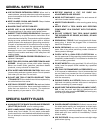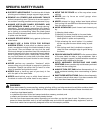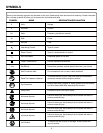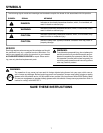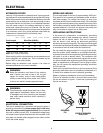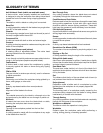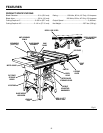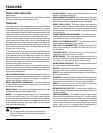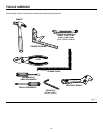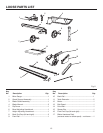
4
5
WARNING:
Some dust created by power sanding, sawing, grinding, drilling, and other construction activities contains chemi-
cals known to cause cancer, birth defects or other reproductive harm. Some examples of these chemicals are:
• lead from lead-based paints,
• crystalline silica from bricks and cement and other masonry products, and
• arsenic and chromium from chemically-treated lumber.
Your risk from these exposures varies, depending on how often you do this type of work. To reduce your ex-
posure to these chemicals: work in a well ventilated area, and work with approved safety equipment, such as
those dust masks that are specially designed to filter out microscopic particles.
SPECIFIC SAFETY RULES
n SUPPORT LARGE PANELS. To minimize risk of blade
pinching and kickback, always support large panels.
n REMOVE ALL FENCES AND AUXILIARY TABLES
before transporting saw. Failure to do so can result in
an accident causing possible serious personal injury.
n ALWAYS USE BLADE GUARD, SPREADER, AND
ANTI-KICKBACK PAWLS on all "through-sawing"
operations. Through-sawing operations are those in
which the blade cuts completely through the workpiece
as in ripping or crosscutting. Keep the blade guard
down, the anti-kickback pawls down, and the spreader
in place over the blade.
n ALWAYS SECURE WORK firmly against rip fence or
miter fence.
n ALWAYS USE A PUSH STICK FOR RIPPING
NARROW STOCK. A push stick is a device used to
push a workpiece through the blade instead of using
your hands. Size and shape can vary but the push
stick must always be narrower than the workpiece to
prevent the push stick from contacting the saw blade.
When ripping narrow stock, always use a push stick,
so your hand does not come close to the saw blade.
Use a featherboard and push blocks for non-through
cuts.
n NEVER perform any operation "freehand" which
means using only your hands to support or guide the
workpiece. Always use either the rip fence or miter
fence to position and guide the work.
n NEVER stand or have any part of your body in line
with the path of the saw blade.
n NEVER reach behind, over, or within three inches of
the blade or cutter with either hand for any reason.
n MOVE THE RIP FENCE out of the way when cross-
cutting.
n NEVER use rip fence as cutoff gauge when
crosscutting.
n NEVER attempt to free a stalled saw blade without
first turning the saw OFF and disconnecting the saw
from the power source.
n AVOID KICKBACKS (work thrown back toward you)
by:
A. Keeping blade sharp.
B. Keeping rip fence parallel to the saw blade.
C. Keeping spreader, anti-kickback pawls, and
blade guard in place and operating.
D. Not releasing the work before it is pushed
all the way past the saw blade using a push
stick.
E. Not ripping work that is twisted or warped or
does not have a straight edge to guide along
the fence.
n PROVIDE ADEQUATE SUPPORT to the rear and sides
of the saw table for wide or long workpieces. Use a
sturdy "outrigger" support if a table extension more than
24 inches long is attached to the saw.
n AVOID AWKWARD OPERATIONS AND HAND
POSITIONS where a sudden slip could cause your hand
to move into the cutting tool.
n ALWAYS TURN OFF SAW before disconnecting it, to
avoid accidental starting when reconnecting to power
supply.
n SAVE THESE INSTRUCTIONS. Refer to them frequently
and use to instruct other users. If you loan someone this
tool, loan them these instructions also.






